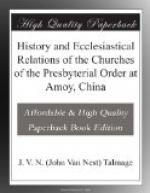The English Presbyterians, as they are accustomed to speak of all the Classes of our Church in America, call this Classis at Amoy “a Presbytery.” Hence the question has been put to us with all sincerity and gravity, “Is it a Classis, or is it a Presbytery?” Some seem to be afraid that the Church we are forming will be half Dutch and half Presbyterian, and that it will soon be swallowed up by the Presbyterians! Are there any ministers, or elders, or intelligent members of the Dutch Church, who have yet to learn that a Classis is a Presbytery, and that the Dutch Church is a Presbyterian Church? Surely not. Why, then, such questions and suggestions? Can they be designed to prejudice the Church at home against the ecclesiastical body which has grown up at Amoy? We will not impute such a motive, and, therefore, I merely say that we are surprised at all such remarks. It is proper for the English Presbyterian brethren to speak of the Presbytery at Amoy. They never speak of it as an English Presbytery. They do not regard it as a part of the Church in England, but as a purely Chinese Church. They have liberality enough to assist in building up such a Church, even though it has some things peculiar to us, for it has all the essentials of their own order. Will it not seem to them that our Church is deficient in liberality, when they learn the decision of the last Synod?
In connection with this subject, it is proper to speak more particularly of the liberality of the English Presbyterian Church. When it is remembered that that Church is really a branch of the Free Church of Scotland, it will not be supposed that their liberality is the result of indifference to anything which they regard essential or important. Seldom has our world witnessed such sacrifice for the sake of principle as was exhibited by that Church, when she came out from the Establishment. Their liberality is a beautiful illustration of the Christian spirit. The course of their Missionaries at the first organization of a church at Amoy, and the approval thereof, have been already alluded to. In consequence of the recent formation of a Classis, the subject naturally came up again this year. It was laid before their Synod, which met a few weeks previous to ours. In the report of their Foreign Committee, which corresponds to our Board of Foreign Missions, the following language is used in reference to the Church at Amoy:




